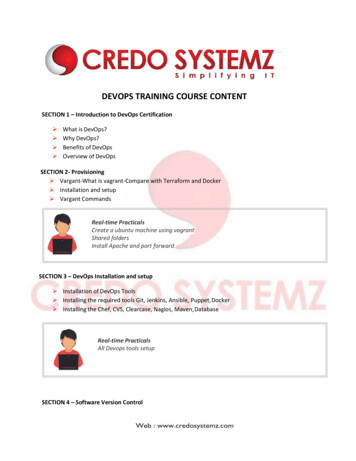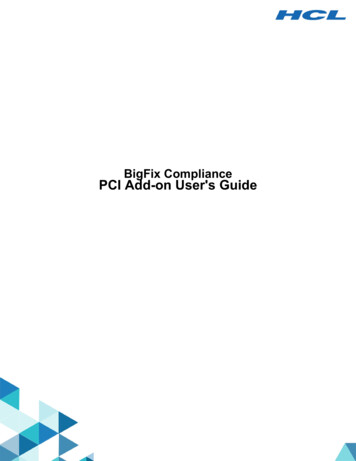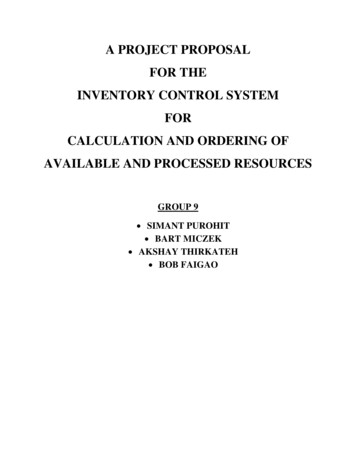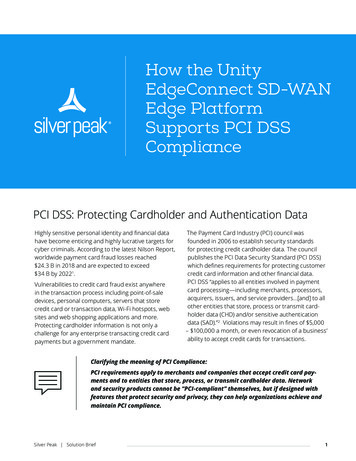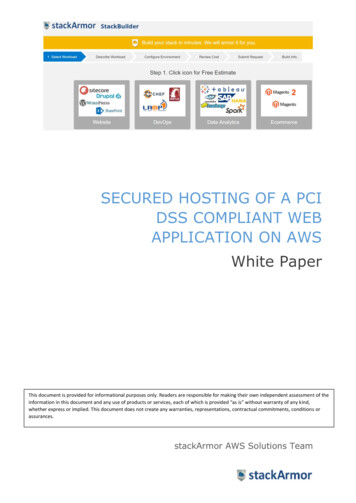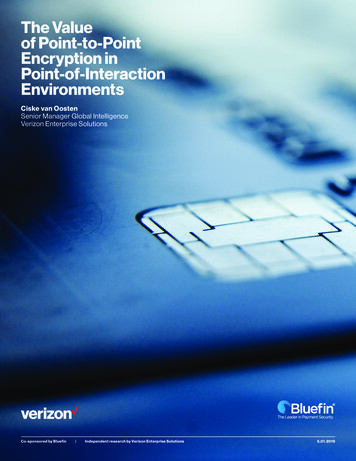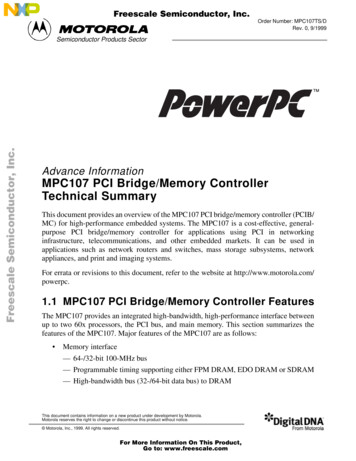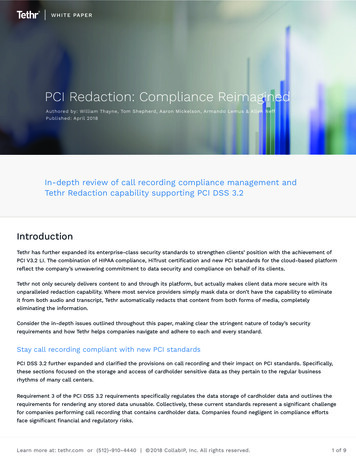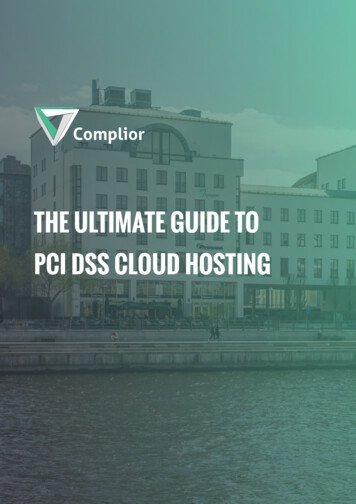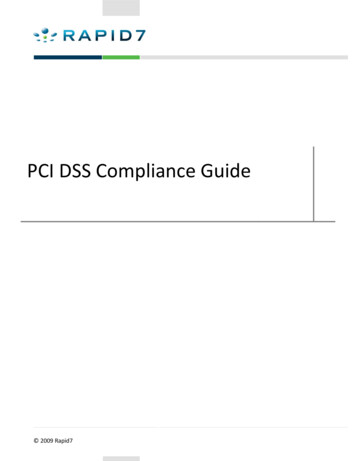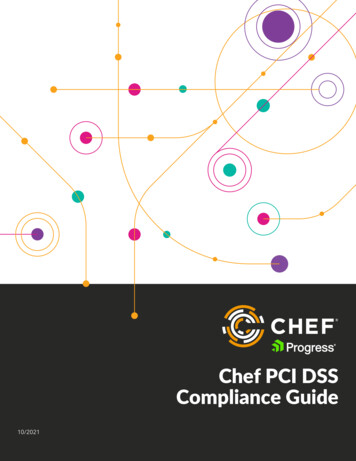
Transcription
Chef PCI DSSCompliance Guide10/20211
Executive SummaryIf a company handles credit card data in any way, they are therefore subject to the Payment Card Industry DataSecurity Standard (PCI DSS). It is well-known that PCI audits can be difficult and time-consuming to execute. Thequicker and easier it is to pass a PCI audit the better it is for an organization. Chef believes the quickest and easiestway for an organization to pass a PCD audit is by implementing a PCI Continuous Assessment approach. This guide iswritten for members of both technical and compliance teams working with systems in any CDE. Traditionally, theseteams run on-demand assessments during a PCI DSS audit. This guide illustrates how to, at a minimum, use ChefCompliance to validate system configurations during an audit in order to map existing manual functions toautomated controls.Table of ContentsIntroduction .2PCI DSS and CIS Controls .3About Chef Compliance .3Chef Continuous Compliance Cycle . 4PCI Requirements .5Requirement 1: Install and Maintain a Firewall Configuration to Protect Cardholder Data . 6Requirement 2: Do Not Use Vendor-Supplied Defaults for System Passwords and Other SecurityParameters . 7Requirement 3: Protect Stored Cardholder Data . 13Requirement 4: Encrypt transmission of cardholder data across open, public networks . 14Requirement 5: Protect all Systems Against Malware and Regularly Update AV Software . 14Requirement 6: Develop and Maintain Secure Systems and Applications . 16Requirement 7: Restrict access to cardholder data by business need to know. 18Requirement 8: Identify and Authenticate Access to System Components . 20Requirement 10: Track and Monitor all Access to Network Resources and Cardholder Data . 23Requirement 11: Regularly Test Security Systems and Processes . 25Requirements 9 & 12 . 26Conclusion . 26Legal Disclaimer . 26ABOUT PROGRESS. 27
IntroductionMaintaining PCI DSS compliance is a struggle for many organizations, particularly those that have experienced a databreach.The 2020 Verizon Payment Security Report found that only 27% of organizations were able to maintain fullcompliance with the PCI-DSS, an 8.8% drop from the year before. Further, the report found that companies in the retail,hospitality, and finance industries struggled the most with PCI DSS requirements.A typical approach to passing a PCI DSS audit is to issue ad-hoc remote commands to gather information, composeverification scripts to run by hand, or to manually verify a number of system settings in tandem with auditors by usingapproaches like screenshots. This approach is fundamentally unsustainable since it requires custom work, is specific to thecontext of your PCI DSS audit, and cannot be leveraged in other parts of business-critical workflows, such as checking forcompliance in pre-production environments.Adopting a continuous compliance approach allows you to quickly answer audit questions at any time, not just quarterlyor yearly. With Chef Compliance, you can enter an audit cycle knowing your exact compliance posture, rather than beingsurprised by auditors who find weak points in your environment. You can identify compliance issues or policy breachesrapidly and react quickly to triage and remediate problems even before auditors show up, allowing you to demonstrate howcompliance has evolved and improved over time.Chef InSpec is a security hardening, testing and auditing tool that turns your compliance, security, and other policyrequirements into automated tests. These tests are designed to continuously gather data about your systems using astandardized language and data format thatclearly map to the compliance controls your auditors care about. ChefCompliance has several packaged compliance rulesets that cover industry-standard use cases. However, if rules for yourspecific use case do not exist, Chef Compliance allows you to easily compose them. Chef Compliance is designed to leveragethe same automated testing used in other parts of your organization to make discussions with your compliance auditorseasier and faster to resolve.This guide covers the 12 PCI DSS security requirements that apply to all system components included in or connected to theCDE. For each requirement, this guide illustrates how to use existing Chef Compliance controls -- or create new controls -to verify compliance.2
PCI DSS and CIS ControlsThe Payment Card Industry Data Security Standard (PCI DSS) provides baseline technical and operational requirementsdesigned to protect account data. PCI DSS contains 12 major requirements with corresponding testing procedures used forcompliance assessments as part of an entity’s validation process. While PCI DSS comprises a minimum set of requirementsfor protecting account data, it may be enhanced by additional controls and practices to further mitigate risks.The Center for Internet Security (CIS) publishes a set of controls that collectively form a defense-in-depth set of bestpractices that mitigate the most common attacks against systems and networks. The CIS Benchmarks are developed bya community of IT experts who apply their first-hand experience as cyber defenders to create a set of globally acceptedsecurity best practices. As a result, the CIS Benchmarks have matured by an international community of individuals andinstitutions that not only identify, track, and remediate cyber security attacks, but also map those controls to regulatoryandcompliance frameworks.This guide uses mappings of CIS controls to PCI DSS standards to inspect a Red Hat Enterprise Linux 7 system forcompliance. A subscription to CIS benchmarks for other operating systems, expressed in Chef InSpec, is included with aChefCompliance license.About Chef ComplianceChef Compliance is built on Chef core technology proven in large, complex environments over the past 10 years. It isdesigned to help enterprises maintain compliance and prevent security incidents across heterogeneous hybrid and multicloudenvironments while improving speed and efficiency. Standards-based audit and remediation content, easily-tunedbaselines and comprehensive visibility and control make it easy to maintain and enforce compliance across your entire fleet.Chef Compliance helps automate the standards by incorporating compliance processes into every stage of thedevelopmentcycle based on the following Chef underlying core technologies: Chef InSpec allows developers and systems engineers to replace lengthy and opaque security specificationdocuments – written in PDF or Excel – with unambiguous tests that are easily readable by all parties involved:security engineers, auditors, systems administrators, and others. Chef Automate provides a standard set of security baselines you can easily customize and extend. Examples ofbaselines included are CIS Compliance Benchmarks and several DISA STIGs. Chef Automate can convert existing,hard-to-use formats to human-readable InSpec in order to take advantage of NIST baselines published in thoseformats. Chef Infra configuration management can be used to remediate any findings and keep systems in theircorrect,remediated state, thereby ensuring continuous compliance.3
Chef Continuous Compliance Cycle Acquire - access trusted content aligned to industry benchmarks for audit and remediation. Withremediation content, organizations can ensure remediation actions align directly to audit results. Define - define compliance baselines and tune them to your organization’s unique needs. Flexible compliancewaiver capabilities allow teams to turn on/off individual controls to avoid false positives and misconfigurations. Detect - continuously monitor and evaluate your compliance posture by detecting deviations from intendedstateat any point in the software delivery lifecycle. Remediate - new remediation capabilities allow you to address non-compliant nodes with individual controlsthat align with audit tests. Remediation is easily applied, without requiring coding skills to ensure CIS and DISAstandards. Report - immutable record in maintaining comprehensive and up-to-date visibility across heterogeneousenvironments, easily view differences between baseline and remediated states, and track waiver status to enablefast and accurate audits any time.Chef Compliance’s collaboration capabilities allow all parties involved in pre-production development processes andproduction operations the ability to see, in real-time, the compliance status of any infrastructure. No longer do teams needto rely on expensive, infrequently used tools accessible only by security engineers. With Chef Compliance, IT organizationscan move from being reactive about compliance issues to always being compliant – and being able to prove it at any time.4
Chef Compliance helps organizations reduce risk, increase speed, and improve efficiency. With security capabilities in ChefCompliance, DevOps teams can work closely with their InfoSec counterparts to ensure the software they ship is compliantand secure, turning InfoSec into an enabler rather than an inhibitor of velocity. Chef Compliance enables collaborationamongInfrastructure, Operations and Information Security teams, and is available in two options tailored to the needs ofthese audiences:Chef Compliance: helps security and operations teams maintain complete visibility over the compliance posture of theirestate. It comes with extensive audit content based on Center for Internet Security (CIS) benchmarks and DefenseInformation Systems Agency (DISA) standards that can be easily fine-tuned to meet specific organization needs. Itprovides up-to-date visibility across any on-premises or cloud environment.Chef Compliance Automation: built for DevOps and Infrastructure teams to help close the loop between audit andremediation and enable continuous compliance in the enterprise. Remediation functionality and trusted, standardsbasedcontent make it easy to remediate issues uncovered during audits without writing any code.Chef Premium Content: delivers Chef-curated content for audits, remediation and desktop configuration that is based onCIS (Center for Internet Security) certified benchmarks or DISA Security Technical Implementation Guides (STIGs). Chefcontinuously maintains and updates the Premium Content library and, whenever an updated or new profile is identified,Chefquickly certifies the content and makes it available for content subscribers.PCI RequirementsThe requirements of the Payment Card Industry Data Security Standard encompass a variety of concerns with respect to thecardholder data environment). The CDE is comprised of people, processes and technologies that store, process, or transmitcardholder data or sensitive authentication data. The scope of a PCI DSS audit also includes interviews, process reviews, andinspection of physical assets. For the purposes of this document, we will focus on the inspection of “system components”within the CDE, including network devices, servers, hypervisors, virtual machines, and application software.While some of the requirements focus on processes and policy not applicable on the systems level, the sections belowcontain an illustrate some of the CIS benchmarks included with Chef Compliance to address 10 of the 12 major auditrequirements of the PCI DSS.These controls are referenceable as a demo profile to use against a Red Hat Enterprise Linux 7 server. The controls referenceunderlying CIS Benchmarks, which are partially shown in the sections below that walk through how these controls operatein practice. This whitepaper and the associated demo profile are an introductory approach to how an organization coulduseChef Automate to address PCI DSS requirements. They are not an exhaustive guide for complete implementation.5
The PCI DSS requirements covered by this whitepaper are:1 - Install and maintain a firewall configuration to protect cardholder data2 - Do not use vendor-supplied defaults for system passwords and other security parameters arenot used 3 - Protect stored cardholder data4 - Encrypt transmission of cardholder data across open, publicnetworks 5 - Use and regularly update anti-virus software orprograms6 - Develop and maintain secure systems and applications7 - Restrict access to cardholder data by business need-toknow 8 - Assign a unique ID to each person with computeraccess10 - Track and monitor all access to network resources and cardholderdata 11 - Regularly test security systems and processesPCI DSS requirements 9 and 12 concern physical security and processes, respectively, and cannot be validated usingautomated approaches.Requirement 1: Install and Maintain a Firewall Configuration to Protect Cardholder DataAny devices connecting to the internet should use a firewall to limit access to open ports. Section 1.4 of the PCI DSS(Firewall software or equivalent) can be addressed with the CIS benchmark ruleset (Limitation & Control of Network Ports) toensure firewall rules for all open ports.1. Ensure firewall rules for all open portsAny ports that have been opened on non-loopback addresses need firewall rules to govern traffic. Without a firewall ruleconfigured for open ports, the default firewall policy should drop all packets to these ports.This control uses Ruby code to create a list of all open system ports listening to non-loopback addresses. The controlalsogathers a list of all currently implemented IPTables rules. The control ensures each open port listening on non-loopback addresses has an associated IPTables rule with both an inbound and outbound entry.6
control "cisecurity.benchmarks rule 3.6.5 Ensure firewall rules foropen ports" dotitle "Ensure firewall rules exist for all open ports"desc "Any ports that have been opened on non-loopback addresses needfirewall rules to govern traffic. Rationale: Without a firewall ruleconfigured for open ports default firewall policy will drop all packetsto these ports."impact 1.0tag "cis-rhel7-2.1.1": "3.6.5"tag "level": "1"tag "type": ["Server", "Workstation"]port.where { protocol /.*/ && port 0 && address / (?!127\.0\.0\.1 ::1 ::).* / }.entries.each do entry rule inbound "-A INPUT -p #{entry[:protocol]} -m#{entry[:protocol]} --dport #{entry[:port]} -m state --stateNEW,ESTABLISHED -j"rule outbound "-A OUTPUT -p #{entry[:protocol]} -m#{entry[:protocol]} --sport #{entry[:port]} -m state --state ESTABLISHED-j A"describe iptables doit { should have rule(rule inbound) }it { should have rule(rule outbound) }endendendRequirement 2: Do Not Use Vendor-Supplied Defaults for System Passwords and OtherSecurity ParametersMalicious individuals (external and internal to an entity) often use vendor default passwords and other vendor defaultsettings to compromise systems. These passwords and settings are well known by hacker communities and are easilydetermined via public information.Section 2.1 of the PCI DSS (Always change vendor-supplied defaults) can be addressed with the CIS benchmark ruleset(Controlled use of Administrative Privileges). Five examples are shown below.1. Ensure password creation requirements are configuredStrong passwords protect systems from being hacked through brute force methods. Settings that require strong passwordsare often a good way to ensure common vendor-supplied default passwords are not used on a system. The system shouldenforce use of strong passwords.7
control "cisecurity.benchmarks rule 5.3.1 Ensure password creationrequirements" dotitle "Ensure password creation requirements are configured"desc "The pam pwquality.so module checks the strength of passwords.The settings shown above are one possible policy. Alter these valuesto conform to your own organization's password policies. Rationale:Strong passwords protect systems from being hacked through brute forcemethods."impact 1.0tag "cis-rhel7-2.1.1": "5.3.1"tag "level": "1"tag "type": ["Server", "Workstation"]describe file('/etc/pam.d/system-auth') doits('content') { shouldmatch(/ \s*password\s requisite\s pam pwquality\.so\s (\S \s )*tryfirst pass/) }its('content') { shouldmatch(/ \s*password\s requisite\s pam pwquality\.so\s (\S \s )*retry [3210]/) }enddescribe file('/etc/pam.d/password-auth') doits('content') { shouldmatch(/ \s*password\s requisite\s pam pwquality\.so\s (\S \s )*tryfirst pass/) }its('content') { shouldmatch(/ \s*password\s requisite\s pam pwquality\.so\s (\S \s )*retry [3210]/) }enddescribe file('/etc/pam.d/password-auth') doits('content') { shouldmatch(/ \s*password\s requisite\s pam pwquality\.so\s (\S \s )*tryfirst pass/) }its('content') { shouldmatch(/ \s*password\s requisite\s pam pwquality\.so\s (\S \s )*retry [3210]/) }enddescribe parse config file('/etc/security/pwquality.conf') doits('minlen') { should match(/1[4-9] [2-9][0-9] [1-9][0-9][0-9] /) }its('dcredit') { should match(/-[1-9][0-9]{0,}/) }its('ucredit') { should match(/-[1-9][0-9]{0,}/) }its('ocredit') { should match(/-[1-9][0-9]{0,}/) }its('lcredit') { should match(/-[1-9][0-9]{0,}/) }endend8
The pam pwquality.so module checks the strength of passwords. It performs checks such as making sure a password is notadictionary word, is a certain length, contains a mix of characters (e.g. alphabet, numeric, other) and more. The controlabove inspects the content of the pam.d system-auth and password-auth config files to ensure: try first pass - retrieve the password from a previous stacked PAM module. If not available, thenprompt the user for a password. retry 3 - Allow 3 tries before sending back a failure.It also inspects the settings in the pwquality.conf to ensure the following password strength settings: minlen 14 - password must be 14 characters or more dcredit -1 - provide at least one digit ucredit -1 - provide at least one uppercase character ocredit -1 - provide at least one special character lcredit -1 - provide at least one lowercase characterThese values can be tuned to the needs of your individual organization.2. Ensure system accounts are non-loginIt’s important to make sure that vendor-provided accounts are not being used by regular users and that they arepreventedfrom providing an interactive shell.9
control "cisecurity.benchmarks rule 5.4.2 Ensure system accounts arenon-login" dotitle "Ensure system accounts are non-login"desc "There are a number of accounts provided with Red Hat 7 thatare used to manage applications and are not intended to provide aninteractive shell. Rationale: Prevent them from being used to provide aninteractive shell."impact 1.0tag "cis-rhel7-2.1.1": "5.4.2"tag "level": "1"tag "type": ["Server", "Workstation"]describe passwd.where { user / (?!root sync shutdown halt).* / } doits("entries") { should not be empty }enddescribe passwd.where { user / (?!root sync shutdown halt).* / &&uid.to i 1000 && shell ! "/sbin/nologin" } doits("entries") { should be empty }endend10
This control inspects settings for all system accounts. By default, Red Hat Enterprise Linux 7 sets the password field forthese accounts to an invalid string. Therefore, their password entries. should not be empty. It also looks at all accounts withUID below 1000 to ensure that the shell field in the password file be set to /sbin/nologin. This prevents the account frompotentially being used to run any commands.3. Ensure password fields are not emptyAll accounts, including vendor-supplied accounts, must have passwords or be locked to prevent the account from being usedby an unauthorized user. If an account has an empty password field that means that anybody may authenticate as that userwithout providing a password.control "cisecurity.benchmarks rule 6.2.1 Ensure password fields arenot empty" dotitle "Ensure password fields are not empty"desc "An account with an empty password field means that anybodymay log in as that user without providing a password. Rationale: Allaccounts must have passwords or be locked to prevent the account frombeing used by an unauthorized user."impact 1.0tag "cis-rhel7-2.1.1": "6.2.1"tag "level": "1"tag "type": ["Server", "Workstation"]shadow.users(/. /).entries.each do entry describe entry doits('passwords') { should not eq [''] }endendendThis control uses Ruby along with InSpec built-in functions to iterate through every user account in /etc/shadow. For eachaccount found, it ensures its password is not empty.11
4. Ensure inactive password lock is 30 days or lessInactive accounts pose a threat to system security. This includes vendor-supplied accounts, which should be automaticallydisabled if they have not been accessed in 30 days or less. Further, this protects the system from inactivity that may preventusers from noticing anomalies in their accounts.In this example, the control uses an in-line Bash script to inspect the output of the “getent shadow” command. The scripthandles the logic for examining the system and InSpec simply examines the exit code of the script. This approach is useful forintegrating existing tools or scripts already in use throughout your organization.control "cisecurity.benchmarks rule 5.4.1.4 Ensure inactive pass lockis 30 days or less" dotitle "Ensure inactive password lock is 30 days or less"desc "User accounts that have been inactive for over a given periodof time can be automatically disabled. Rationale: Inactive accounts posea threat to system security since the users are not logging in to noticefailed login attempts or other anomalies."impact 1.0describe file("/etc/default/useradd") doits("content") { shouldmatch(/ \s*INACTIVE\s* \s*(30 [1-2][0-9] [1-9])\s*(\s #.*)? /) }enddescribe bash( "#!/usr/bin/env sh\n\n#\n# CIS-CAT Script CheckEngine\n# \n# NameDateDescription\n# --------------------------------------\n# B. Munyan7/20/16 Ensure no users have a password inactivity period 30\n#\n\noutput (\n/usr/bin/getent shadow awk -F : 'match( 2, / [ !*]/)&& ( 7 \"\" 7 30) { if ( 7 \"\") { print \"User \" 1 \"password inactivity period is not defined\" } else { print \"User \" 1\" Password Inactivity Period 30 (\" 7 \") \" } }'\n)\n\n# we capturedoutput of the subshell, let's interpret it\nif [ \" output\" \"\" ]; then\n exit XCCDF RESULT PASS\nelse\n# print the reasonwhy we are failing\necho \" output\"\nexit XCCDF RESULT FAIL\nfi\n") doits("exit status") { should eq 0 }endend12
Requirement 3: Protect Stored Cardholder DataSection 3 of the PCI DSS examines protection methods for limiting access to critical components of cardholder data, evenwhen it is being accessed by authorized users or by intruders that have circumvented other security controls. Because thisrequirement of the PCI DSS is mainly concerned with potential risk mitigation techniques of custom data, schema, andstorage requirements, there are no “one size fits all” controls included in the CIS controls to account for all possiblescenarios.You must build controls custom to your organizational needs. Chef makes that task easily achievable usingInSpec’s resource model.1. Ensure a non-authorized user cannot reach cardholder dataIn this example, we could write a control to ensure that unauthorized database users cannot access credit card numbers.This example control would connect to a known production Oracle database (ora01. mycompany.com) and attempt toauthenticate as the users “sys”, “system”, and “alice”. In this example we presume that these users should not have accessto stored credit card information. Therefore, when they attempt to select these rows there should be no data returned.control "mycompany.custom rule1.0.0 Ensure non privileged users cantaccess cc numbers" dotitle "Ensure that non-privileged database users do not see CCnumbers"desc "A legitimate and authorized database user account should notbe able to access credit card numbers if they are not specificallyauthorized to do so. Rationale: Only privileged accounts should be ableto access cardholder data."impact 1.0tag "level": "1"tag "type": ["Server", "Workstation"]%w[sys system alice].each do unprivileged describe oracledb session(user: unprivileged, .query('SELECT creditcard FROM accounts').rows doits('count') { should eq 0 }endendend13
Requirement 4: Encrypt transmission of cardholder data across open, public networksSensitive information must be encrypted during transmission over networks that are easily accessed by maliciousindividuals.Section 4.1 of the PCI DSS requires use of strong cryptography and security protocols to safeguard sensitivecardholder dataduring transmission over open, public networks, including use of secure versions. Some protocolimplementations (such as SSL, SSH v1.0, and early TLS) have known vulnerabilities that an attacker can use to gain control ofthe affected system.1. Ensure that the TLS 1.2 protocol is active on any SSL portsIn this example control, we check to see that TLS 1.2 is enabled on any SSL ports listening for connections.control "mycompany.custom rule2.0.0 Ensure TLS v1.2 is in use" dotitle "Ensure that TLS 1.2 is the encryption protocol in use"desc "TLS 1.2 is a known secure protocol that should be used forSSL connections. Rationale: SSL2, SSL3, TLS1.0, and TLS1.1 all containknown vulnerabilities that an attacker can use to gain control of thesesystems."impact 1.0tag "level": "1"tag "type": ["Server", "Workstation"]sslports.each do socket proc desc "on node #{command('hostname').stdout.strip} running#{socket.process.inspect} (#{socket.pid})"describe ssl(port: socket.port).protocols('tls1.2') doit(proc desc) { should be enabled }it { should be enabled }endendendThis control is an example of using InSpec’s built-in “ssl” resource. While this control ensures TLS 1.2 is the active protocolon any SSL ports, it does not ensure that other non-secure protocols are disabled. For a more thorough check of SSLsettings, refer to the dev-sec SSL benchmark.Requirement 5: Protect all Systems Against Malware and Regularly Update AV SoftwareMaintaining a vulnerability management program includes ensuring that system patches and security software is availableand installed on all systems. For RHEL 7 servers, this includes ensuring that all package manager repositories are properlyconfigured so systems may receive vendor-provided updates.1. Ensure package manager repositories are configuredIf a system’s package repositories are misconfigured, important patches may not be identified or a rogue repository could14
introduce compromised software. Systems should have their authorized package manager repositories configured in a waythat ensures they receive the latest patches and updates.This control uses Ruby to iterate through all package repositories defined as Red Hat system repos in the CIS benchmarks.Each of those repositories must be defined on the system and enabled. The control also ensures that repositories set up viayum to install software from additional resources are also defined and enabled on the system.control "cisecurity.benchmarks rule 1.2.1 Ensure pkg manager repos areconfigured" dotitle "Ensure package manager repositories are configured"desc "Systems need to have package manager repositories configuredto ensure they receive the latest patches and updates. Rationale: If asystem's package repositories are misconfigured important patches maynot be identified or a rogue repository could introduce compromisedsoftware."impact 0.0tag "cis-rhel7-2.1.1": "1.2.1"tag "level": "1"tag "type": ["Server", "Workstation"]REDHAT REPOS.each do repository describe yum.repo(repository) doit { should exist }it { should be enabled }endendcmd command('yum repolist enabled').stdout.split("\n")get other repos cmd.slice(2.cmd.length-2) []other repos get other repos.map { repositories repositories.gsub(/\s. /, '') }other repos - REDHAT REPOSunless other repos.empty?other repos.each do repository describe yum.repo(repository) doit { should not exist }it { should not be enabled }endend2. Ensure updates, patches, and additional security software is installedPeriodically, patches are released for included software either due to security flaws or to include additional functionality.Rationale: Newer patches may contain security enhancements that would not be available through the lat
About PCI DSS and CIS controls The Payment Card Industry Data Security Standard (PCI DSS) provides baseline technical and operational requirements designed to protect account data. PCI DSS contains 12 major requirements with corresponding testing procedures used for compliance assessments as part of an entity's validation process.
